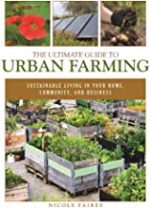 Urban farming is not new but to many it is daunting and outside their comfort range. Nicole Faires shares her knowledge of the subject in her book, The Ultimate Guide to Urban Farming, and provides information to make the subject more approachable to the average gardener. Believing that people can grow their own food in a suburban backyard as well as become a commercial grower in any city, the author offers a comprehensive system for creating and building urban farming as a major source of fresh foods in a city within a relatively short time.
Urban farming is not new but to many it is daunting and outside their comfort range. Nicole Faires shares her knowledge of the subject in her book, The Ultimate Guide to Urban Farming, and provides information to make the subject more approachable to the average gardener. Believing that people can grow their own food in a suburban backyard as well as become a commercial grower in any city, the author offers a comprehensive system for creating and building urban farming as a major source of fresh foods in a city within a relatively short time.
The book is divided into 5 chapters: Community and Business Planning, Design Your Farm, Methods, Plants, and Animals. After discussing different aspects of start-up such as business models, funding, and land acquisition in chapter 1, the author turns to the problems involved in choosing the type of farm to be developed and providing it with the necessary climate, light, water, and soil. The chapter on methods gets down to the nits and grits of soil science, composting, indoor growing, tools, orchard cultivation, food processing options and techniques, seed saving, and production strategies such as succession and interplanting. Especially helpful to any farmer and vegetable gardener are the extensive companion planting table and the information and tables for pest control. The chapter on plants considers cash crops and The Fukuoka system of growing grains, and offers an extensive chart on soil-improving plants and an alphabetical plant and harvest guide while the chapter on animals discusses raising rabbits, chickens, ducks, pigeons and quail, geese, bees, goats, sheep, fish, and seafood.
Although there is much valuable information contained in the book I did not find anything that reassured me about the feasibility of finding suitable land for the venture unless it is a considerable distance from the downtown area of a city, and maybe that is acceptable for urban farming. The author makes a good case for changing the way food is produced and mentions Havana, Cuba as being a model for urban farming; more research on its success would be instructive. Once the land acquisition problem is solved, the book could be very helpful in pursuit of the goal and meanwhile the home vegetable gardener can profit from much of the detailed information on such things as succession and interplanting, companion planting, pest control, and soil improving plants.
To buy The Ultimate Guide to Urban Farming from Amazon.com click here.